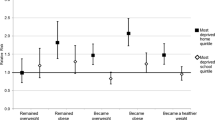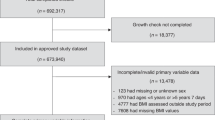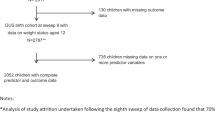Abstract
Objective:
Evidence suggests that area-level deprivation is associated with obesity independently of individual socioeconomic status; however, although the school may also have an impact on child health, few studies have investigated the association between school-level deprivation and the body mass index (BMI) of students. The aim of this study was to assess the relationship between the BMI for children of different ages and area-level and school-level deprivation.
Subjects:
BMI measurements were collected through the National Child Measurement Programme (NCMP) that samples from two school years: 396 171 reception year pupils (4–5-year olds) and 392 344 year 6 pupils (10–11-year olds) from 14 054 primary schools in England.
Design:
Cross-classified multilevel models with four levels: individual (n=788 525), lower super output areas corresponding to area of residence (n=29 606), schools (n=14 054) and primary care trusts (PCTs, n=143), which coordinate the collection of data within a large area, were used to study the relationship between measures of deprivation at an area and school level, and childhood BMI within England.
Results:
A positive association was found between the area and school measures of deprivation, and student BMI. Both the measures of deprivation explained a greater proportion of variance in BMI z-scores for year 6 students than for the reception year students, with a greater difference between the year groups found with the school-level measure of socioeconomic status than for the the area-level measure.
Conclusions:
Deprivation explains a greater proportion of the variance in BMI for older compared with younger children, perhaps reflecting the impact of deprivation as children age, highlighting the widening of health inequalities through childhood. The association with school-level deprivation illustrates the impact of the school on BMI status throughout the primary school years.
This is a preview of subscription content, access via your institution
Access options
Subscribe to this journal
Receive 12 print issues and online access
$259.00 per year
only $21.58 per issue
Buy this article
- Purchase on Springer Link
- Instant access to full article PDF
Prices may be subject to local taxes which are calculated during checkout

Similar content being viewed by others
References
Shrewsbury V, Wardle J . Socioeconomic status and adiposity in childhood: a systematic review of cross-sectional studies 1990–2005. Obesity 2008; 16: 275–284.
Sobal J, Stunkard AJ . Socioeconomic status and obesity: a review of the literature. Psychol Bull 1989; 105: 260–275.
Jansen W, Hazebroek-Kampschreur A . Differences in height and weight between children living in neighbourhoods of different socioeconomic status. Acta Paediatrica 1997; 86: 224–225.
Wang Y, Zhang Q . Are American children and adolescents of low socioeconomic status at increased risk of obesity? Changes in the association between overweight and family income between 1971 and 2002. Am J Clin Nutr 2006; 84: 707–716.
Marmot M, Allen J, Goldblatt P, Boyce T, McNeish D, Grady M et al. Fair Society, Healthy Lives: Strategic Review of Health Inequalities in England post-2010, The Marmot Review. University College London: London, 2010.
Stamatakis E, Wardle J, Cole TJ . Childhood obesity and overweight prevalence trends in England: evidence for growing socioeconomic disparities. Int J Obes 2009; 34: 41–47.
Kinra S, Nelder RP, Lewendon GJ . Deprivation and childhood obesity: a cross sectional study of 20 973 children in Plymouth, United Kingdom. J Epidemiol Community Health 2000; 54: 456–460.
Craig R, Mindell J . The health survey for England 2006: CVD and risk factors adults, obesity and risk factors children. Information Centre: Leeds, 2008.
Stafford M, Brunner EJ, Head J, Ross NA . Deprivation and the development of obesity: a multilevel, longitudinal study in England. Am J Prev Med 2010; 39: 130–139.
Liberatos P, Link BG, Kelsey JL . The measurement of social class in epidemiology. Epidemiol Rev 1988; 10: 87–121.
Krieger N, Williams DR, Moss NE . Measuring social class in US public health research: concepts, methodologies, and guidelines. Annu Rev Public Health 1997; 18: 341–378.
Greves Grow HM, Cook AJ, Arterburn DE, Saelens BE, Drewnowski A, Lozano P . Child obesity associated with social disadvantage of children's neighborhoods. Soc Sci Med 2010; 71: 584–591.
Janssen I, Boyce WF, Simpson K, Pickett W . Influence of individual- and area-level measures of socioeconomic status on obesity, unhealthy eating, and physical inactivity in Canadian adolescents. Am J Clin Nutr 2006; 83: 139–145.
Nelson MC, Gordon-Larsen P, Song Y, Popkin BM . Built and social environments: associations with adolescent overweight and activity. Am J Prev Med 2006; 31: 109–117.
Mehta NK, Chang VW . Weight status and restaurant availability: a multilevel analysis. Am J Prev Med 2008; 34: 127–133.
Mujahid MS, Roux AVD, Shen M, Gowda D, Sanchez B, Shea S et al. Relation between neighborhood environments and obesity in the multi-ethnic study of atherosclerosis. Am J Epidemiol 2008; 167: 1349–1357.
Li F, Harmer P, Cardinal BJ, Bosworth M, Johnson-Shelton D . Obesity and the built environment: does the density of neighborhood fast-food outlets matter? Am J Health Promot 2009; 23: 203–209.
Li F, Harmer P, Cardinal BJ, Bosworth M, Johnson-Shelton D, Moore JM et al. Built environment and 1-year change in weight and waist circumference in middle-aged and older adults: Portland Neighborhood Environment and Health Study. Am J Epidemiol 2009; 169: 401–408.
Li F, Harmer PA, Cardinal BJ, Bosworth M, Acock A, Johnson-Shelton D et al. Built environment, adiposity, and physical activity in adults aged 50–75. Am J Prev Med 2008; 35: 38–46.
Frank LD, Andresen MA, Schmid TL . Obesity relationships with community design, physical activity, and time spent in cars. Am J Prev Med 2004; 27: 87–96.
Santos R, Silva P, Santos P, Ribeiro JC, Mota J . Physical activity and perceived environmental attributes in a sample of Portuguese adults: results from the Azorean Physical Activity and Health Study. Prev Med 2008; 47: 83–88.
Cochrane T, Davey R, Gidlow C, Smith G, Fairburn J, Armitage C et al. Small area and individual level predictors of physical activity in urban communities: a multi-level study in stoke on Trent, England. Int J Environ Res Public Health 2009; 6: 654–677.
Hoehner CM, Brennan Ramirez LK, Elliott MB, Handy SL, Brownson RC . Perceived and objective environmental measures and physical activity among urban adults. Am J Prev Med 2005; (Suppl 2): 105–116.
Townshend T, Lake AA . Obesogenic urban form: theory, policy and practice. Health Place 2009; 15: 909–916.
Sharma M . School-based interventions for childhood and adolescent obesity. Obes Rev 2006; 7: 261–269.
Procter KL, Rudolf MC, Feltbower RG, Levine R, Connor A, Robinson M et al. Measuring the school impact on child obesity. Soc Sci Med 2008; 67: 341–349.
Dinsdale H, Rutter H . National Child Measurement Programme: Detailed Analysis of the 2006/07 National Dataset (Internet). National Obesity Observatory: Oxford, 2008. Available from: http://www.noo.org.uk/uploads/doc168_2_NOO_NCMP_report230608.pdf.
Ridler C, Townsend N, Dinsdale H, Mulhall C, Rutter H . National Child Measurement Programme: Detailed Analysis of the 2007/08 National Dataset (Internet). National Obesity Observatory: Oxford, 2009. Available from: http://www.noo.org.uk/uploads/doc168_2_noo_NCMPreport1_110509.pdf.
Crowther R, Dinsdale H, Rutter H, Kyffin R . Analysis of the National Childhood Obesity Database 2005–06 (Internet). Department of Health: London, 2007. Available from: http://www.dh.gov.uk/prod_consum_dh/groups/dh_digitalassets/@dh/@en/documents/digitalasset/dh_063783.pdf.
Lumeng JC, Appugliese D, Cabral HJ, Bradley RH, Zuckerman B . Neighborhood safety and overweight status in children. Arch Pediatr Adolesc Med 2006; 160: 25–31.
UKCRN. UKCRN GLOSSARY OF TERMS (Internet). 2007. Available from: http://www.ukcrn.org.uk/index/library/literature/mainColumnParagraphs/05/document/glossary.doc.
Cross-Government Obesity Unit. The National Child Measurement Programme—Guidance for PCTs: 2007–08 school year (Internet). Department of Health: London, 2007. Available from: http://www.dh.gov.uk/en/Publicationsandstatistics/Publications/PublicationsPolicyAndGuidance/DH_07868g.
CGOU. Healthy Weight, Healthy Lives: National Child Measurement Programme Guidance for Primary Care Trusts 2009/10 (Internet). Cross Government Obesity Unit: London, 2009. Available from: http://www.dh.gov.uk/prod_consum_dh/groups/dh_digitalassets/documents/digitalasset/dh_103360.pdf.
Cole TJ, Freeman JV, Preece MA . Body mass index reference curves for the UK. Arch Dis Child 1995; 73: 25–29.
Kirkwood BR, Sterne JAC . Essential Medical Statistics. Blackwell Science: Oxford, 2003.
Cole TJ, Freeman JV, Preece MA . British 1990 growth reference centiles for weight, height, body mass index and head circumference fitted by maximum penalized likelihood. Stat Med 1998; 17: 407–429.
Local Index of Child Well-Being (Internet). Communities and Local Government 2009. Available from: http://www.communities.gov.uk/documents/communities/pdf/1126232.pdf.
DCLG. Indices of Deprivation 2007 (Internet). 2008; Available from: http://webarchive.nationalarchives.gov.uk/+/communities.gov.uk/communities/neighbourhoodrenewal/deprivation/deprivation07/.
Barclay P, Dodd K . Super Output Areas (SOAs)—Background for England and Wales data (Internet). Available from: http://www.maiden.gov.uk/Documents/Guide_to_Super_Output_Areas.pdf.
Supporting Information: Lower Layer Super Output Area (Internet). (cited 2010 Aug 17); Available from: http://www.datadictionary.nhs.uk/data_dictionary/nhs_business_definitions/l/lower_layer_super_output_area_de.asp?shownav=0.
Directgov. Free school lunches (Internet). 2009; Available from: http://www.direct.gov.uk/en/Parents/Schoolslearninganddevelopment/SchoolLife/DG_4016089.
Browne W . MCMC estimation in MLwiN. Centre for Multilevel Modelling: Bristol, 2005.
Rasbash J, Steele F, Browne W, Prosser B . A User's Guide to MLwiN. Centre for Multilevel Modelling: Bristol, 2004.
Hox J . Multilevel Analysis Techniques and Applications. Lawrence Erlbaum Associates: London, 2002.
Duncan C, Jones K, Moon G . Health-related behaviour in context: a multilevel modelling approach. Soc Sci Med 1996; 42: 817–830.
Braveman PA, Cubbin C, Egerter S, Chideya S, Marchi KS, Metzler M et al. Socioeconomic status in health research: one size does not fit all. JAMA 2005; 294: 2879–2888.
IC. National Child Measurement Programme: 2007/08 school year, headline results, December 2008. [Internet]. NHS Information Centre for Health and Social Care: Leeds, 2008. Available from: http://www.ic.nhs.uk/webfiles/publications/ncmp/ncmp0708/NCMP%202007-08%20Report.pdf.
Clapp JM, Wang Y . Defining neighborhood boundaries: are census tracts obsolete? J Urban Econ 2006s; 59: 259–284.
Weiss L, Ompad D, Galea S, Vlahov D . Defining neighborhood boundaries for urban health research. Am J Prev Med 2007; 32 (6, Supplement 1): S154–S159.
Acknowledgements
NOO acknowledge the NHS Information Centre (IC) in providing the NCMP data. Core funding for the study was provided by the National Obesity Observatory (NOO). This work was undertaken by the Oxford University and NOO. NOO received funding from the Department of Health; the views expressed in this publication are those of the authors and not necessarily those of the Department of Health.
Author contributions
NT was responsible for statistical analysis and writing the manuscript; he is the guarantor. HR and CF contributed to the development of the study and provided critical review of the manuscript.
Author information
Authors and Affiliations
Corresponding author
Ethics declarations
Competing interests
The authors declare no conflict of interest.
Rights and permissions
About this article
Cite this article
Townsend, N., Rutter, H. & Foster, C. Age differences in the association of childhood obesity with area-level and school-level deprivation: cross-classified multilevel analysis of cross-sectional data. Int J Obes 36, 45–52 (2012). https://doi.org/10.1038/ijo.2011.191
Received:
Revised:
Accepted:
Published:
Issue Date:
DOI: https://doi.org/10.1038/ijo.2011.191
Keywords
This article is cited by
-
Mediators of socioeconomic differences in overweight and obesity among youth in Ireland and the UK (2011–2021): a systematic review
BMC Public Health (2022)
-
Understanding local ethnic inequalities in childhood BMI through cross-sectional analysis of routinely collected local data
BMC Public Health (2019)
-
Area-level deprivation and adiposity in children: is the relationship linear?
International Journal of Obesity (2013)



